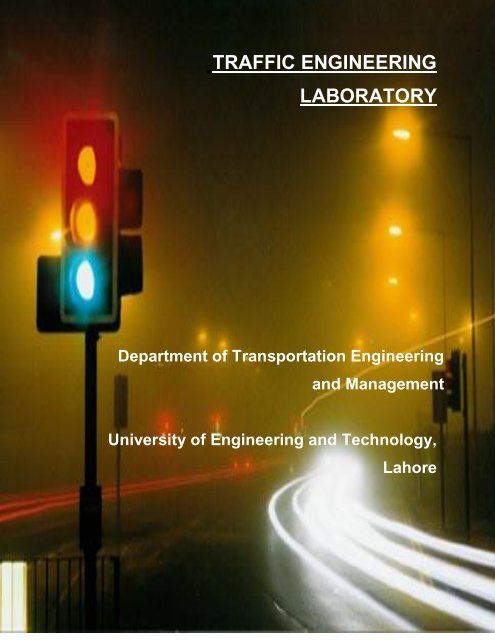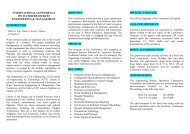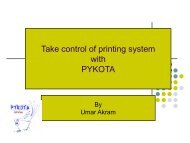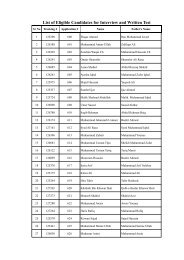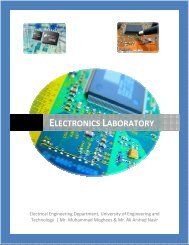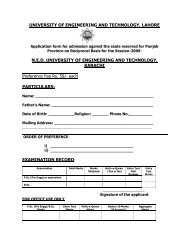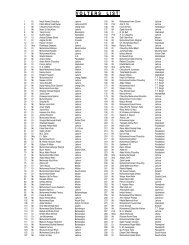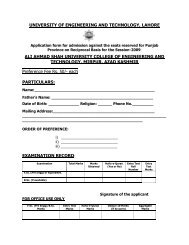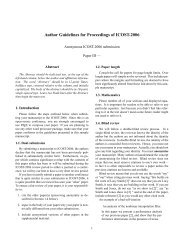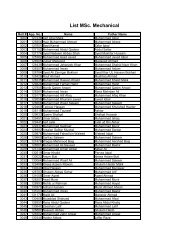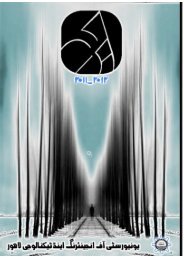Traffic Engineering Lab. - University of Engineering & Technology ...
Traffic Engineering Lab. - University of Engineering & Technology ...
Traffic Engineering Lab. - University of Engineering & Technology ...
You also want an ePaper? Increase the reach of your titles
YUMPU automatically turns print PDFs into web optimized ePapers that Google loves.
TRAFFIC ENGINEERING<br />
LABORATORY<br />
Department <strong>of</strong> Transportation <strong>Engineering</strong><br />
and Management<br />
<strong>University</strong> <strong>of</strong> <strong>Engineering</strong> and <strong>Technology</strong>,<br />
Lahore
Introduction:<br />
The traffic engineering lab is designed to supplement the average juniorlevel<br />
course in transportation engineering. <strong>Lab</strong>oratory exercises are<br />
meant for most <strong>of</strong> the major topics addressed in undergraduate<br />
transportation engineering program. The lab includes a vast collection <strong>of</strong><br />
equipments, to assist students in completing the laboratory exercises, and<br />
to increase their understanding <strong>of</strong> these important topics.<br />
<strong>Lab</strong>oratory staff:<br />
Engr. Farhan Haider<br />
Ibtasam Bashir<br />
Muhammad Nazir<br />
Director/ Assistant pr<strong>of</strong>essor<br />
<strong>Lab</strong> incharge<br />
<strong>Lab</strong>. Assistant<br />
List <strong>of</strong> Equipment:<br />
1. <strong>Traffic</strong> signal controller<br />
2. <strong>Traffic</strong> signal light<br />
3. <strong>Traffic</strong> cones<br />
4. <strong>Traffic</strong> safety vests<br />
5. Television, CD, LG<br />
6. Measuring wheel
List <strong>of</strong> experiments<br />
1. <strong>Traffic</strong> Counting/Measuring Methods:<br />
a. Manual Classified Counts (MMC)<br />
I. Tally Sheets<br />
II. Mechanical Counting Boards/Meters<br />
III. Electronic Counting Boards/Meters<br />
b. Automatic Counters<br />
I. Portable Counters<br />
II. Permanent Counters<br />
2. <strong>Traffic</strong> Signal Timing Design:<br />
a. <strong>Traffic</strong> Signal Warrants<br />
b. Cone <strong>of</strong> Vision Study<br />
c. Cycle Length Determination<br />
d. Timing Adjustments<br />
e. Signal Coordination<br />
f. Capacity <strong>of</strong> Saturation Flow Rate<br />
g. Inter Green Time<br />
h. Pedestrian Green Time and Minimum Green Interval<br />
i. Peak Hour Volume, Design Flow Rate and Peek Hour Factor<br />
j. Computing Delays and Level <strong>of</strong> Service (LOS)<br />
3. Accident Analysis:<br />
a. Formation <strong>of</strong> Standard <strong>Traffic</strong> Accident Report Form<br />
b. Collision Diagrams<br />
c. Police <strong>Traffic</strong> Accident Report<br />
4. Intersection Study<br />
a. Intersection Volume Study<br />
b. Intersection Geometry Study
c. Sight Distance Study at Intersection<br />
d. Signal Timing Diagram<br />
e. Vehicle Arrival Patterns at Intersection<br />
f. Saturation Flow Rate Measurement<br />
5. Parking Design Study and Pedestrian Study<br />
6. Delay Measurement at a <strong>Traffic</strong> Intersection<br />
7. Training on <strong>Traffic</strong> Signal Controllers, <strong>Traffic</strong> Signal Lights<br />
and Count Down Meters.<br />
8. <strong>Traffic</strong> Analysis S<strong>of</strong>tware<br />
a. Highway Capacity S<strong>of</strong>tware (HCS 2000)<br />
b. Synchro and Sim <strong>Traffic</strong> Simulation<br />
c. Vissum
<strong>Lab</strong>oratory View


